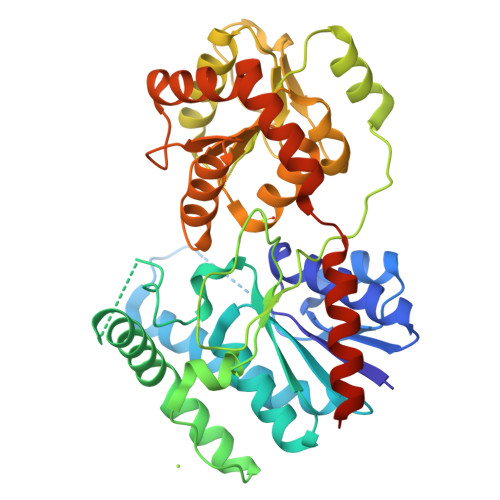Structure of the UDP-glucosyltransferase GtfB that modifies the heptapeptide aglycone in the biosynthesis of vancomycin group antibiotics.
Mulichak, A.M., Losey, H.C., Walsh, C.T., Garavito, R.M.(2001) Structure 9: 547-557
- PubMed: 11470430
- DOI: https://doi.org/10.1016/s0969-2126(01)00616-5
- Primary Citation of Related Structures:
1IIR - PubMed Abstract:
Members of the vancomycin group of glycopeptide antibiotics have an oxidatively crosslinked heptapeptide scaffold decorated at the hydroxyl groups of 4-OH-Phegly4 or beta-OH-Tyr6 with mono- (residue 6) or disaccharides (residue 4). The disaccharide in vancomycin itself is L-vancosamine-1,2-glucose, and in chloroeremomycin it is L-4-epi-vancosamine-1,2-glucose. The sugars and their substituents play an important role in efficacy, particularly against vancomycin-resistant pathogenic enterococci. The glucosyltransferase, GtfB, that transfers the glucose residue from UDP-glucose to the 4-OH-Phegly4 residue of the vancomycin aglycone, initiating the glycosylation pathway in chloroeremomycin maturation, has been crystallized, and its structure has been determined by X-ray analysis at 1.8 A resolution. The enzyme has a two-domain structure, with a deep interdomain cleft identified as the likely site of UDP-glucose binding. A hydrophobic patch on the surface of the N-terminal domain is proposed to be the binding site of the aglycone substrate. Mutagenesis has revealed Asp332 as the best candidate for the general base in the glucosyltransfer reaction. The structure of GtfB places it in a growing group of glycosyltransferases, including Escherichia coli MurG and a beta-glucosyltransferase from T4 phage, which together form a subclass of the glycosyltransferase superfamily and give insights into the recognition of the NDP-sugar and aglycone cosubstrates. A single major interdomain linker between the N- and C- terminal domains suggests that reprogramming of sugar transfer or aglycone recognition in the antibiotic glycosyltransferases, including the glycopeptide and also the macrolide antibiotics, will be facilitated by this structural information.
Organizational Affiliation:
Department of Biochemistry and Molecular Biology, Michigan State University, East Lansing, MI 48824, USA.


















